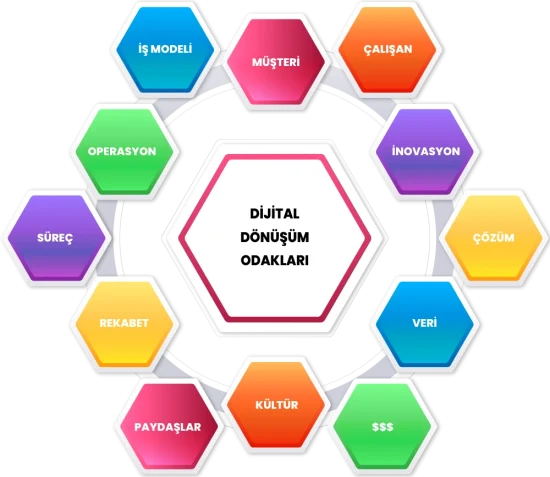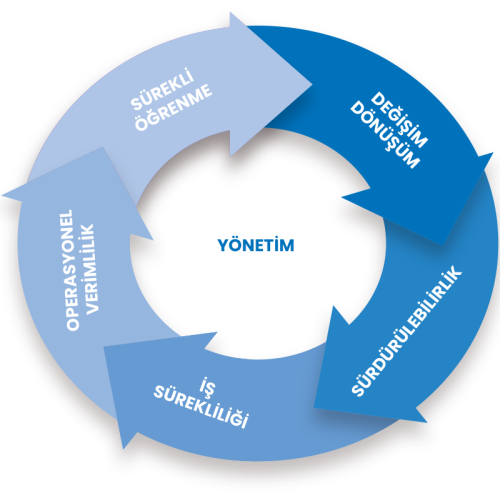Digital Transformation
Where Does the Digital Transformation Journey Begin or End?

Digitalization processes that only large organizations focus on is now on the agenda of all companies, regardless of scale.
Especially with technological advancements becoming more and more involved in business processes, both horizontally and vertically, and even evolving processes, the rate of achieving speed, efficiency and more effective results has increased more than ever before.
The digital transformation journey, an integral part of the information society, makes more information more usable at lower costs. However, for success, it must be prioritized by all employees and levels, and a common goal is critical.
While digitalization processes used to be the focus of attention only for large corporations, today they have gained an important place on the agenda of all companies, regardless of scale. In particular, the increasing integration of technological developments into business processes is contributing significantly to the evolution of the business world, both horizontally and vertically. These developments offer unique opportunities for companies to increase their speed, optimize their efficiency and achieve more effective results.
Going beyond traditional boundaries, digitalization enables companies to gain competitive advantage by transforming their business processes. Increasing automation, data analytics and artificial intelligence applications make workflows smarter and more effective, enabling more efficient use of resources.
Technological evolution offers companies various opportunities to improve customer experience, increase operational excellence and make business strategies more agile. In this way, companies must actively embrace digital transformation to survive in a highly competitive market and achieve sustainable growth.
Digitalization processes have become a priority for all companies and a critical factor for the future success of the business world. In this context, companies' openness to technological innovations, integration with the ever-evolving digital ecosystem and strengthening their adaptation capabilities form the basis of a successful digital transformation process.

While digital transformation stands out as an indispensable element of the information society, this evolution process not only increases access to more information, but also makes this information available at lower costs and more effectively. This process aims to improve business processes, increase efficiency and become more competitive by utilizing the opportunities offered by technology.
However, for digital transformation to be successful, it is necessary to ensure the participation of all employees and levels in this transformation process. This means that not only senior management but also all employees should be made aware of digitalization, supported with trainings and embrace the vision of this transformation.
It is critical for the success of digital transformation that the workforce is focused and united around a common purpose. This means creating a digital culture within the company. and encouraging employees at all levels to contribute to digital ambitions. This also includes understanding that the digital transformation process is not only a technological change, but also an organizational transformation.
In conclusion, digital transformation is not only a technological change but also an organizational transformation process shaped with the participation of all employees in order to successfully move forward in the dynamics of the information society and gain competitive advantage. Therefore, adopting digital transformation as a strategic priority and sharing this vision across the entire company is a critical step towards sustainable success for the future.

Corporate Governance Cycle in Digital Transformation
There is no doubt that change and transformation starts with people, and the first condition for success is for organizations to review their own competencies for digital transformation by focusing on change and to offer the necessary development and change programs to their stakeholders.
Macro planning and micro-level implementation and promotion are essential for the transformation of target audiences that are much larger and have different dynamics, including not only the organization's employees but also its dealers, suppliers and even customers.
Human Element in Digital Transformation:Competencies and Behaviors, Training and Development Programs
Undoubtedly, any change and transformation process is fundamentally based on the mindset, competencies and behaviors of individuals. Before starting the digital transformation journey of organizations, special emphasis should be placed on the human element that triggers and directs this change process. In this context, the first step for organizations to make digital transformation successful by evaluating their internal dynamics, culture and individual competencies is to consider these basic elements.
Digital transformation does not only mean strengthening the technological infrastructure; it also requires employees to develop their digital skills, review old habits and be open to innovation. Therefore, organizations should create training and development programs to ensure that employees understand how they can contribute to digital transformation.
A change-oriented perspective enables organizations to review existing processes, business models and even organizational cultures. This review is an important step in identifying the change needs within the company and designing appropriate strategies to meet these needs. Organizations should prioritize the new competencies and skills required by digital transformation and guide their employees in this regard.
It is also crucial to correctly identify stakeholders and understand their expectations for a successful digital transformation process. Organizations should create a common vision by sharing their digital transformation strategies with their stakeholders and work collaboratively to realize this vision.
As a result, the digital transformation process can succeed with a holistic strategy that includes the active participation of employees, managers and stakeholders, without ignoring the human factor. This should include an understanding of transformation that focuses not only on technological innovation, but also on people's adaptability to change.
Digital Transformation Strategy:Macro, micro, broad ecosystem transformation, promotion strategy
Digital transformation must be planned and implemented not only for internal employees, but also for a broad target audience, including dealers, suppliers and customers that make up the organization's broader ecosystem. This process requires comprehensive strategic planning at the macro level and the implementation and promotion of these strategies at the micro level.
At a macro level, organizations should approach their transformation from a broad ecosystem perspective, rather than one that focuses only on internal processes. This means understanding, assessing and responding to the changing expectations, needs and demands of dealers, suppliers and customers. At this point, organizations should develop an outward-looking digital transformation strategy in collaboration with a wide range of stakeholders.
At the micro level, various operational details need to be considered for the effective implementation and adoption of the identified strategies. This includes, for example, focusing on specific objectives such as increasing digital competencies for dealers and suppliers, improving digital experiences for customers and making processes more efficient.
A sustainable promotion strategy is also critical to the success of the transformation process. This includes the establishment of training programs, communication strategies and continuous feedback mechanisms to ensure the adoption of a digital transformation culture among employees, vendors, suppliers and customers.
As a result, when creating digital transformation strategies, organizations should not only focus on internal processes, but also think from a broad ecosystem perspective, develop macro- and micro-level strategies, and effectively implement these strategies to create a positive impact on a wide range of stakeholders.

